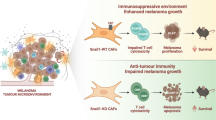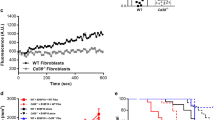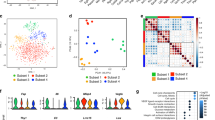Abstract
The tumor microenvironment is emerging as an important target for cancer therapy. Fibroblasts (Fbs) within the tumor stroma are critically involved in promoting tumor growth and angiogenesis through secretion of soluble factors, synthesis of extracellular matrix and direct cell–cell interaction. In this work, we aim to alter the biological activity of stromal Fbs by modulating the Notch1 signaling pathway. We show that Fbs engineered to constitutively activate the Notch1 pathway significantly inhibit melanoma growth and tumor angiogenesis. We determine that the inhibitory effect of ‘Notch-engineered’ Fbs is mediated by increased secretion of Wnt-induced secreted protein-1 (WISP-1) as the effects of Notch1 activation in Fbs are reversed by shRNA-mediated blockade of WISP-1. When ‘Notch-engineered’ Fbs are co-grafted with melanoma cells in SCID mice, shRNA-mediated blockade of WISP-1 reverses the tumor-suppressive phenotype of the ‘Notch-engineered’ Fbs, significantly increases melanoma growth and tumor angiogenesis. Consistent with these findings, supplement of recombinant WISP-1 protein inhibits melanoma cell growth in vitro. In addition, WISP-1 is modestly expressed in melanoma-activated Fbs but highly expressed in inactivated Fbs. Evaluation of human melanoma skin biopsies indicates that expression of WISP-1 is significantly lower in melanoma nests and surrounding areas filled with infiltrated immune cells than in the adjacent dermis unaffected by the melanoma. Overall, our study shows that constitutive activation of the Notch1 pathway confers Fbs with a suppressive phenotype to melanoma growth, partially through WISP-1. Thus, targeting tumor stromal Fbs by activating Notch signaling and/or increasing WISP-1 may represent a novel therapeutic approach to combat melanoma.
This is a preview of subscription content, access via your institution
Access options
Subscribe to this journal
Receive 50 print issues and online access
$259.00 per year
only $5.18 per issue
Buy this article
- Purchase on Springer Link
- Instant access to full article PDF
Prices may be subject to local taxes which are calculated during checkout






Similar content being viewed by others
References
Allinen M, Beroukhim R, Cai L, Brennan C, Lahti-Domenici J, Huang H et al. (2004). Molecular characterization of the tumor microenvironment in breast cancer. Cancer Cell 6: 17–32.
Anton K, Glod J . (2009). Targeting the tumor stroma in cancer therapy. Curr Pharm Biotechnol 10: 185–191.
Artavanis-Tsakonas S, Rand MD, Lake RJ . (1999). Notch signaling: cell fate control and signal integration in development. Science 284: 770–776.
Balint K, Xiao M, Pinnix CC, Soma A, Veres I, Juhasz I et al. (2005). Activation of Notch1 signaling is required for beta-catenin-mediated human primary melanoma progression. J Clin Invest 115: 3166–3176.
Bhowmick NA, Neilson EG, Moses HL . (2004). Stromal fibroblasts in cancer initiation and progression. Nature 432: 332–337.
Chen PP, Li WJ, Wang Y, Zhao S, Li DY, Feng LY et al. (2007). Expression of Cyr61, CTGF, and WISP-1 correlates with clinical features of lung cancer. PLoS One 2: e534.
Crawford Y, Kasman I, Yu L, Zhong C, Wu X, Modrusan Z et al. (2009). PDGF-C mediates the angiogenic and tumorigenic properties of fibroblasts associated with tumors refractory to anti-VEGF treatment. Cancer Cell 15: 21–34.
Davies SR, Watkins G, Mansel RE, Jiang WG . (2007). Differential expression and prognostic implications of the CCN family members WISP-1, WISP-2, and WISP-3 in human breast cancer. Ann Surg Oncol 14: 1909–1918.
Dufraine J, Funahashi Y, Kitajewski J . (2008). Notch signaling regulates tumor angiogenesis by diverse mechanisms. Oncogene 27: 5132–5137.
Hayward SW, Wang Y, Cao M, Hom YK, Zhang B, Grossfeld GD et al. (2001). Malignant transformation in a nontumorigenic human prostatic epithelial cell line. Cancer Res 61: 8135–8142.
Ishikawa Y, Onoyama I, Nakayama KI, Nakayama K . (2008). Notch-dependent cell cycle arrest and apoptosis in mouse embryonic fibroblasts lacking Fbxw7. Oncogene 27: 6164–6174.
Kalluri R . (2009). EMT: when epithelial cells decide to become mesenchymal-like cells. J Clin Invest 119: 1417–1419.
Kalluri R, Neilson EG . (2003). Epithelial–mesenchymal transition and its implications for fibrosis. J Clin Invest 112: 1776–1784.
Kalluri R, Zeisberg M . (2006). Fibroblasts in cancer. Nat Rev Cancer 6: 392–401.
Li Y, Song Y, Zhao L, Gaidosh G, Laties AM, Wen R . (2008). Direct labeling and visualization of blood vessels with lipophilic carbocyanine dye DiI. Nat Protoc 3: 1703–1708.
Liu ZJ, Herlyn M . Molecular Biology of Cutaneous Melanoma, 7th edn. Lippincott Williams & Wilkins: Philadelphia, (2005).
Liu ZJ, Shirakawa T, Li Y, Soma A, Oka M, Dotto GP et al. (2003). Regulation of Notch1 and Dll4 by vascular endothelial growth factor in arterial endothelial cells: implications for modulating arteriogenesis and angiogenesis. Mol Cell Biol 23: 14–25.
Liu ZJ, Tian R, An W, Zhuge Y, Li Y, Shao H et al. (2010). Identification of E-selectin as a novel target for the regulation of postnatal neovascularization: implications for diabetic wound healing. Ann Surg 252: 625–634.
Liu ZJ, Xiao M, Balint K, Smalley KS., Brafford P, Qiu R et al. (2006). Notch1 signaling promotes primary melanoma progression by activating mitogen-activated protein kinase/phosphatidylinositol 3-kinase–Akt pathways and upregulating N-cadherin expression. Cancer Res 66: 4182–4190.
Liu ZJ, Zhuge Y, Velazquez OC . (2009). Trafficking and differentiation of mesenchymal stem cells. J Cell Biochem 106: 984–991.
Lorusso G, Ruegg C . (2008). The tumor microenvironment and its contribution to tumor evolution toward metastasis. Histochem Cell Biol 130: 1091–1103.
Lynch CC, Matrisian LM . (2002). Matrix metalloproteinases in tumor–host cell communication. Differentiation 70: 561–573.
Mailhos C, Modlich U, Lewis J, Harris A, Bicknell R, Ish-Horowicz D . (2001). Delta4, an endothelial specific notch ligand expressed at sites of physiological and tumor angiogenesis. Differentiation 69: 135–144.
Meier F, Nesbit M, Hsu MY, Martin B, Van Belle P, Elder DE et al. (2000). Human melanoma progression in skin reconstructs: biological significance of bFGF. Am J Pathol 156: 193–200.
Midwood KS, Williams LV, Schwarzbauer JE . (2004). Tissue repair and the dynamics of the extracellular matrix. Int J Biochem Cell Biol 36: 1031–1037.
Noguera-Troise I, Daly C, Papadopoulos NJ, Coetzee S, Boland P, Gale NW et al. (2006). Blockade of Dll4 inhibits tumour growth by promoting non-productive angiogenesis. Nature 444: 1032–1037.
Olumi AF, Grossfeld GD, Hayward SW, Carroll PR, Tlsty TD, Cunha GR . (1999). Carcinoma-associated fibroblasts direct tumor progression of initiated human prostatic epithelium. Cancer Res 59: 5002–5011.
Orimo A, Gupta PB, Sgroi DC, Arenzana-Seisdedos F, Delaunay T, Naeem R et al. (2005). Stromal fibroblasts present in invasive human breast carcinomas promote tumor growth and angiogenesis through elevated SDF-1/CXCL12 secretion. Cell 121: 335–348.
Orimo A, Weinberg RA . (2006). Stromal fibroblasts in cancer: a novel tumor-promoting cell type. Cell Cycle 5: 1597–1601.
Pennica D, Swanson TA, Welsh JW, Roy MA, Lawrence DA, Lee J et al. (1998). WISP genes are members of the connective tissue growth factor family that are upregulated in wnt-1-transformed cells and aberrantly expressed in human colon tumors. Proc Natl Acad Sci USA 95: 14717–14722.
Pinnix CC, Lee JT, Liu ZJ, McDaid R, Balint K, Beverly LJ et al. (2009). Active Notch1 confers a transformed phenotype to primary human melanocytes. Cancer Res 69: 5312–5320.
Ridgway J, Zhang G, Wu Y, Stawicki S, Liang WC, Chanthery Y et al. (2006). Inhibition of Dll4 signalling inhibits tumour growth by deregulating angiogenesis. Nature 444: 1083–1087.
Sakamoto K, Yamaguchi S, Ando R, Miyawaki A, Kabasawa Y, Takagi M et al. (2002). The nephroblastoma overexpressed gene (NOV/ccn3) protein associates with Notch1 extracellular domain and inhibits myoblast differentiation via Notch signaling pathway. J Biol Chem 277: 29399–29405.
Sappino AP, Skalli O, Jackson B, Schurch W, Gabbiani G . (1988). Smooth-muscle differentiation in stromal cells of malignant and non-malignant breast tissues. Int J Cancer 41: 707–712.
Soon LL, Yie TA, Shvarts A, Levine AJ, Su F, Tchou-Wong KM . (2003). Overexpression of WISP-1 downregulated motility and invasion of lung cancer cells through inhibition of Rac activation. J Biol Chem 278: 11465–11470.
Tanaka S, Sugimachi K, Saeki H, Kinoshita J, Ohga T, Shimada M et al. (2001). A novel variant of WISP1 lacking a von Willebrand type C module overexpressed in scirrhous gastric carcinoma. Oncogene 20: 5525–5532.
Thurston G, Noguera-Troise I, Yancopoulos GD . (2007). The delta paradox: DLL4 blockade leads to more tumour vessels but less tumour growth. Nat Rev Cancer 7: 327–331.
Urs S, Roudabush A, O'Neill CF, Pinz I, Prudovsky I, Kacer D et al. (2008). Soluble forms of the Notch ligands Delta1 and Jagged1 promote in vivo tumorigenicity in NIH3T3 fibroblasts with distinct phenotypes. Am J Pathol 173: 865–878.
Yin L, Velazquez OC, Liu ZJ . (2010). Notch signaling: emerging molecular targets for cancer therapy. Biochem Pharmacol 80: 690–701.
Zeisberg M, Kalluri R . (2008). Fibroblasts emerge via epithelial–mesenchymal transition in chronic kidney fibrosis. Front Biosci 13: 6991–6998.
Acknowledgements
We thank Dr M Herlyn for providing the melanoma cells (1205Lu, WM35, WM3248, Sbcl2, WM278 and WM3899) and Dr G McNamara for laser-scanning confocal microscopy. The work of Dr Liu was supported by grants from the James & Esther King Biomedical Research Program (08KN-10) and the Bankhead-Coley Cancer Research Program (09BN-11).
Author information
Authors and Affiliations
Corresponding author
Ethics declarations
Competing interests
The authors declare no conflict of interest.
Rights and permissions
About this article
Cite this article
Shao, H., Cai, L., Grichnik, J. et al. Activation of Notch1 signaling in stromal fibroblasts inhibits melanoma growth by upregulating WISP-1. Oncogene 30, 4316–4326 (2011). https://doi.org/10.1038/onc.2011.142
Received:
Revised:
Accepted:
Published:
Issue Date:
DOI: https://doi.org/10.1038/onc.2011.142
Keywords
This article is cited by
-
Reprogramming of cancer-associated fibroblasts by apoptotic cancer cells inhibits lung metastasis via Notch1-WISP-1 signaling
Cellular & Molecular Immunology (2022)
-
Cell Communication Network Factor 4 (CCN4/WISP1) Shifts Melanoma Cells from a Fragile Proliferative State to a Resilient Metastatic State
Cellular and Molecular Bioengineering (2020)
-
The emerging role of WISP proteins in tumorigenesis and cancer therapy
Journal of Translational Medicine (2019)
-
In the Wnt-er of life: Wnt signalling in melanoma and ageing
British Journal of Cancer (2016)
-
Targeted deactivation of cancer-associated fibroblasts by β-catenin ablation suppresses melanoma growth
Tumor Biology (2016)



